Features of the choice and use of electric planers

Power tools in our time are very common and diverse. Many manufacturers offer their products of approximately the same quality and consumer properties. This was especially evident when companies from China and other South Asian countries entered the instrumental market. This fully applies to electric planers. The purpose of this article is to help a potential buyer choose the right tool.

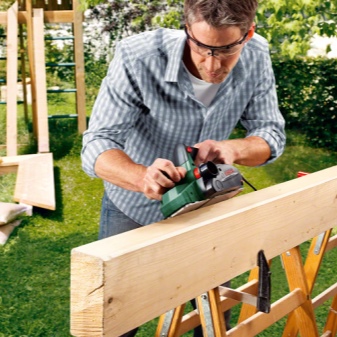
Features and purpose
An electric planer is a tool designed for woodworking by planing. Planing is the uniform removal of the surface layer. It is necessary to create a flat and smooth surface, depending on the further purpose - finishing, grinding, fitting parts for further installation or construction. Earlier - before the era of the power tool - these works were carried out using hand planers and required considerable experience and skill. It was necessary to calculate (or rather, feel from experience) the force of pressing, the extension of the blade, the direction of movement of the tool.


Electricity has revolutionized this complex, not all accessible business.
Now, with more or less success, any person can plan boards after little practice and mastering the features of operating the apparatus.



Instrument device
All electric planers are generally arranged the same, with varying degrees of complication, depending on the purpose of the instrument. The diagram shows this in sufficient detail. An example is the Interskol plane. But in his place could well have been anyone else.
The main node apparatus, its "heart" is an electric motor that rotates cutter - the main working tool, with the help of which direct planing takes place. It is metallic drum with replaceable knives. In addition to the main working unit, the electric planer includes various regulators: frequency of rotation of the shaft of the electric motor, the depth of material processing. These regulators are simple, mechanical or electromechanical, depending on the purpose.

All this is based on metal sole, a kind of horizontal slab. The sole of the instrument is usually made of aluminum or aluminum alloy. Its front part is movable and can be moved up and down to a preset height in millimeters with the help of the regulator. The height of the position of the front of the sole in relation to the surface of the back is the depth of processing of the material. This is the thickness of the layer removed from the surface of the planed board.

In "amateur" models, this layer is 2-3 mm, in professional - 4 and more. Regulator of the thickness of the removed layer most often equipped with a scale with a graduation of 1/10 mm. On the front of the sole, there must be longitudinal grooves to allow the flow of air that is formed during rotation snare drum.
In addition, these grooves can be chamfered quickly and easily.

Working bodies are concluded into the case... It is made of durable plastic. Bearings are installed in the attachment points of the rotating parts. In the upper outer part there are main tool controls - start button and fuse button that blocks unauthorized start of the electric motor. This is to avoid possible injury. Electric motor covered with a ventilated casing.
In addition, the body has holesthrough which sawdust and shavings are blown out by a stream of air from a rotating drum. This is the basic structure of an electric plane. The whole difference is in the quality of the materials used and the reliability of the units.

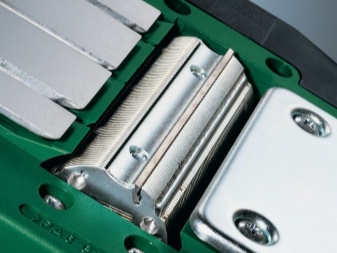
Views
According to the energy source, electric planers are accumulator and network. Rechargeable the devices are lighter, more compact, can be used in places where there is no electricity. Of course, in these cases, their operating time is limited until the next charging of the power supply. They also have limitations on the power of the electric motor. The thing, of course, is convenient in terms of autonomy, but a professional or just a good owner usually has both a battery and a network planer.
Network planer It is connected to a 220 V consumer power grid using a cable with a connector and an extension cord. The network allows you to work with a tool of any power for an almost unlimited time at a distance equal to the length of the cable. Therefore, the mains and battery planers complement each other to a great extent.
It should be noted that battery planers are, as a rule, significantly more expensive than network ones.


In addition, electric planers are tacitly subdivided into household (amateur) and professional. This division is not advertised anywhere and does not have strict criteria, however, experts know that household planers have a width and depth of processing 82 and 3 mm, respectively, and professional planes - from 110, and 4 and more millimeters in depth. The engine power for household appliances is from 600 to 1500 W, and for professional ones - up to 2500 and above. And there are many other features that, as a rule, are only important for specialists.
Such planers also differ in price. Sometimes at times.


Rating of the best models
Among household planers, buyers' sympathies are distributed approximately as follows.
- Makita KP0800. The brand is Japanese but made in China. Reliable, simple and easy-to-use unit. Consumes power from 620 watts. This power is sufficient for 17,000 engine idle rpm. These characteristics are enough to perform all planing work necessary in everyday life. Price from 8 thousand rubles.

- DeWalt DW680... An American brand that has proven itself for many years. Produced in the Czech Republic. The power characteristics are slightly lower than those of the previous device, but their ratio is very satisfactory for buyers. It is also important that the drum, knives and bearings, on which it all rests, have great strength and reliability. Price - from 9.5 thousand rubles.


- Bosch planers of the GHO series. Made in China under the control of a German firm with a long history. These tools can be classified as semi-professional. Power indicators are impressive: power from 650 to 850 watts, revolutions from 14000 to 18000. High reliability of the working unit, simplicity and safety in handling. Price from 8 to 18 thousand rubles.


- Black & Decker KW series. Designed in the USA, Made in China. Household electric planers of the "democratic" segment. Price from 3500 to 4700 rubles. Power 650 W, idle speed - 17,000 per minute. There are complaints about minor flaws, but the price suits many. One of the most popular brands in Russia.
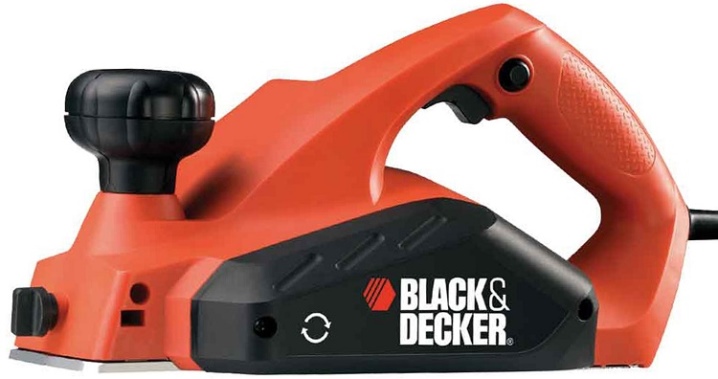
- "Zubr"... Easy-to-use and relatively inexpensive Russian-made planers. Household models cost from 3 to 4 thousand rubles, professional - from 6 to 7 thousand rubles. They are distinguished by high power and high rpm. Consumables are always on sale. You can hear complaints about unreliability, but this is a matter of luck and warranty service. The ratio between price and quality is optimal.

- Interskol... A well-known Russian company for the production of tools and construction equipment. Electric planes "Interskol" are very popular in Russia because of the optimal price. Household segment devices cost from 3 to 4.5 thousand rubles. Consumables are always on sale.

Only the main brands are listed - from relatively expensive to more democratic. Prices are approximate. There are many models of other brands on the market at lower prices, but you cannot vouch for their stable quality and long work. If we get lucky. That is why these models should not be recommended.
In the models of well-known companies, it is also valuable that they can be converted into mini machines. The set includes a special stand, or bed, on which the plane is fixed. The result is a stationary bench-top machine for processing small wooden parts (sander or jointer).


Such versatility is very much appreciated by consumers, but not all manufacturers succeed in such "combinations". Here in terms of quality, all the same Makita, DeWalt, Bosch and some others are in the lead. Their products are often supplied in special cases with a set of additional equipment and consumables. Useful accessories may include corrugated hose like a vacuum cleaner for removing sawdust and shavings, as well as a special bag for collecting them.
Both Russian and little-known Chinese manufacturers are beginning to adopt these pleasant features for the buyer, but the quality is still lame.
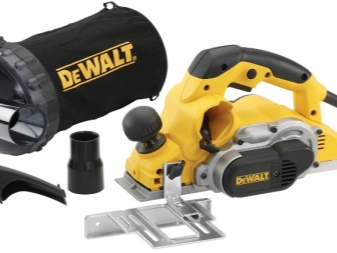
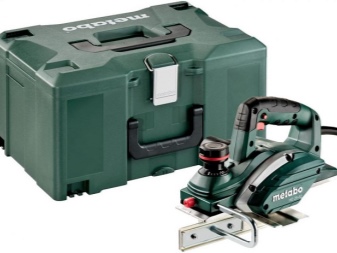
How to choose?
The first step is to pay attention to purpose of the plane, the main characteristics (power and dimensional), as well as find out how things are with warranty service... The latter is important: even the top leaders of the market sometimes have a marriage. In all cases, experts recommend a power of at least 600 W and an idle speed of at least 15,000 per minute. Such characteristics will make it possible to process even very hard wood.
The further choice depends primarily on the purpose of the upcoming use of the tool. This thing is purely rational, and the approach should be extremely practical. If we are talking about the processing of materials for the home, maintenance and household (periodic use with low load), then you should think about the "household" line of electric planers of any of the top market leaders. Important here reliability, quality and availability of consumables for sale (knives). If the consumer is faced with the task of one-time processing of a small amount of material, then a very inexpensive option can be purchased. But the strength characteristics must be unchanged.


If a person intends to engage in carpentry and carpentry professionally, then he, of course, will come to the need to acquire a professional tool. Professional level planers have greater reliability, resistance to loads and, of course, increased power characteristics. The motor power ranges from 1100 to 2500 watts. The width of the processed surface often exceeds 82 mm for everyday use and reaches 300 mm in some models. An experienced specialist has at his disposal several professional planers with different dimensional characteristics. Each - for its specific task.
It should be remembered that the price of some planers reaches several tens of thousands of rubles.
Professional planers can do more than just wood. With the help of special knives and additional equipment, they can also work on metal (very limited types of work) and drywall. But this is a purely special tool, and has nothing to do with household planing.

How to set up correctly?
Before doing any adjustments and settings, you need to carefully read the instructions for the electric plane. And all further actions must comply with this instruction. Before starting work, you need conduct an external inspection of the tool... Are the switches working correctly? Whether the knife drum rotates freely. Does the forefoot of the sole of the planer respond to the turns of the depth adjuster?
Test the tool on any unnecessary board at the minimum working depth. Is the plane running smoothly, is there any vibration, uneven planing, waviness. If so, more complex setup work is likely to be required.
- Adjusting the parallelism of the front and back of the planer sole... The front part of the sole is movable: raising or lowering it with the help of a special handle, they regulate the depth of planing. Sometimes, after prolonged use, the parallelism of the front platform in relation to the rear platform is disturbed. Non-parallelism is established using a rigid ruler application. Eliminated, as a rule, by disassembling the plane, removing the regulator, front panel, thorough cleaning of the parts. The result at the end of the reassembly is again checked with a ruler.
- Adjusting the position of the knives. The minimum or zero value of the thickness of the removed layer is set. The edge of the knife blade should be flush with the back of the sole. Using a ruler or any solid flat plate applied to the sole above the drum, it is checked that the knives do not touch it. If touched, then their position is leveled using special bolts. The blade should not protrude more than 0.5 mm above the drum surface.
To perform these procedures for the first time, it is best to see a specialist. With time and experience, the planer owner will be able to carry out these works independently, especially since there is a lot of video information on the Internet. And we should not forget about the need thorough cleaning of the tool at the end of work. This is the guarantee of its durable and high-quality work.


How to make an electric plane with your own hands?
Some craftsmen are sometimes tempted make an electric plane at home do it yourself. However, this device, for all its apparent simplicity, is a complex engineering product, which can be fully manufactured only in the factory. You can, of course, make it yourself. There are helpful tips and even step-by-step instructions on the internet. But such a homemade "miracle of technology", most likely, will not fully work or, even worse, will be traumatic.
This direction of technical thought was understandable 30 years ago, when such tools were a curiosity. But now, with an abundance of models of various modifications and prices in stores, this makes no sense. We can talk about the independent production of not the plane itself, but a mini-machine based on it. The photo shows a primitive planer based on electric planer, fixed on the workbench in the "sideways" position. The workpiece is fed by hand, sliding along the surface of the workbench.


There are many more complex "inventions":
- with a clamping device that provides a more accurate feed of the workpiece to the working drum;
- with clamping attachment to a regular table;
- with a system for setting the angles of workpiece processing.
This kind of invention makes sense. It is far from always and not everywhere that such devices can be purchased industrially. And if possible, then they either do not suit the consumer, or are too expensive.

Manufacturers of electric planers have recently paid attention to this "creativity" and they also began to supply the simplest beds in the set of planers. Electric planers are a dynamically developing segment of the tool market. Already, perhaps, you will not find a good owner in Russia who does not have this valuable unit at home. And in the country and in a private house, this tool is completely irreplaceable.
In particular, and for economic reasons: it is known that raw materials are much cheaper than processed ones. And even a low-power household planer will allow you to process several cubic meters of boards for the construction of a fence, utility block, toilet. Therefore, the variety of manufacturers and models of electric planers will only expand in the future. In this situation, it is important to correctly orient the consumer.

The following video provides an overview of popular models of electric planers.













The comment was sent successfully.